OM DHANVANTARAYE NAMAHA

Painting by Jaya Rama Dasa (1977) oil on canvas, for
illustration in Shrimad Bhagavatam Copyright BBTI
The origins of the ancient healing science known as Ayurveda are lost
in cosmic antiquity. According to the ancient text Caraka-samhita, this
"Science of Life and Longevity" is eternal and is revealed in each universe
in each of its infinite cycles of creation and destruction. This healing
science is generally revealed by great sages or demigods. Occasionally,
the Supreme Lord Himself descends as the avatara (incarnation) Dhanvantari
and re-inaugurates the tradition of Ayurveda. This extremely rare appearance
of God is recorded in the Vedic literature of ancient India.
Dhanvantari's appearance is celebrated each year on the 13th day (trayodasi)
of the waxing moon a few days before the Divali, corresponding to October
17 in this year of 1998. Follow these links to enjoy the story, and rare
pictures, and even a recital of the stotra of the avatar of Dhanvantari.
The Birth of the Unborn
http://www.avatara.org/dhanvantari/dhanlila.html
The avatara of Dhanvantari appeared billions of years ago. Although
an avatara is unborn, He takes His divine birth among the living beings
to display His divine pastimes.
The First Appearrance of Dhanvantari
In this epoch (kalpa), He first appeared during the great churning of
the cosmic milk ocean to deliver amrta (nectar) for the nourishment of
the demigods. The churning of the milk ocean is one of the most famous
episodes in Puranic history and is celebrated in major way every twelve
years in the festival known as Kumbha Mela. The story is related in the
Srimad Bhagavatam, a major work that describes the avataras in great detail.
Here is what happened:
The great leader of the demigods Indra was riding on his elephant, when
he came across Durvasa Muni. Seeing the great demigod, Durvasa offered
him a special garland (mala). Indra accepted this garland and put it on
the trunk of the elephant. The elephant threw the garland onto the floor,
thus enraging Durvasa Muni. In a fit of anger, the sage explained that
the garland was the dwelling of Sri (fortune) and was therefore to be treated
as prasada. (1) Therefore cursed Indra and all the demigods to be bereft
of all strength, energy, and fortune (Sri).
In the ensuing battles, the demigods were defeated in battle and the
demons headed by Bali gained control of the universe. The demigods sought
out the help of Lord Vishnu, who instructed them in the art of diplomacy.
The demigods then entered into an alliance with the demons to jointly churn
the ocean for the nectar of immortality and to share it among them. Of
course, the demigods were told by Vishnu that He would arrange for them
alone to obtain the nectar, which would empower them to defeat the demons.
All kinds of herbs were cast into the milk ocean and using Mandara mountain
as the churning rod and Vasuki as the cord, they proceeded to churn the
ocean. This churning was so arduous that Lord Vishnu Himself interceded
in so many ways to aid the demigods: He was present as Lord Ajita pulling
on the side of the gods, as Lord Kurma who supported the great Mandara
mountain which was in danger of sinking, and Lord Vishnu Himself sat atop
the Mountain infusing the demigods and the serpent Vasuki with energy.
Many great beings and objects were produced from the ocean and were accepted
by various demigods as offerings. Laksmi-devi, the goddess of fortune,
appeared from the ocean and Vishnu and Her were reunited as husband and
wife after having been separated for many ages.
Then as they continued churning, a very wonderful male person appeared.
The Bhagavatam tells us, "He was strongly built; His arms were very long,
stout and strong; His eyes were reddish, and His complexion was black.
He was very young, He was garlanded with flowers, and His entire body was
fully decorated with various ornaments." (2)
Lord Dhanvantari was "dressed in yellow garments and wore brightly polished
earrings made of pearl. The tips of His hair were anointed with oil and
His chest was very broad. His body had all good features, and He was stout
and strong as a lion. In His hand, He carried a jug of nectar."
The demons stole the jug of nectar and Lord Vishnu appeared as Mohini,
a beautiful woman, who fascinated the demons and recovered the nectar from
them. The demigods took the nectar and drank it and were invigorated with
energy. Thereafter, the demigods fought the demons and were victorious.
They greatly rejoiced and worshipped Lord Vishnu and Lakshmi, the goddess
of fortune, and resumed their position in the heavens.
Dhanvantari's Second Appearance (3)
The second appearance occurred at the beginning of the reign of the
current Manu in the second Dvapara-yuga, two billion years ago. Lord Vishnu
foretold at the time of the churning that Dhanvantari would appear again
in the human society and be offered sacrifices and worshipped by human
beings. He would also teach them the science of Ayurveda. Dhanvantari at
that time was residing in the heavens and Lord Indra seeing the misery
of human beings afflicted by disease on earth, requested the Lord to teach
Ayurveda to the human race.
At the same time, the King Dirghatamas of Kasi was performing penance,
desiring a son. The king desired to propitiate Lord Dhanvantari for the
sake of a son. Thereupon, Dhanvantari appeared to him and urged the king
to choose a boon as he pleased. The king said, "O Lord, if You are pleased
with me, be my son, bestower of my goal." The Lord replied, "So be it,"
and He vanished.
Lord Dhanvantari was then born in the royal household of Kasi. He developed
ascetic tendencies even as a young boy and performed severe austerities.
Lord Brahmawith great difficulty persuaded Him to accept lordship over
the city of Kasi and since then He bacame known as Kasi-raja. As a king
He prepared the samhitas on Ayurveda in eight divisions for the benefit
of humanity.
Lord Dhanvantari's teachings are recorded in the Agni Purana 279-289
as well as through the teachings of His disciple Susrutha.
The Bhagavatam states "smrta-matrarti-nasanah" One who remembers the
name of Dhanvantari can be released from all disease.
A final note:
Those who are new to Vaishnava and Puranic thought may wonder at the
purpose of the Lord's array of avatars especially during the churning of
the milk ocean. After all if God is all powerful, why couldn't He accomplish
all His ends at once? Why does He have to act through so many different
forms? In answer to this, the Vedic literature affirms the omnipotence
of the Lord in His various avatars. However, when the Lord descends, He
Lord seamlessly fuses His serious purpose (in protecting the demigods and
humanity) with sheer sport. In the form of Mohini, He enchants the demons
and the demigods. As Lord Dhanvantari, He diminishes the misery of the
world by teaching the medical sciences. As Lord Ajita, He enjoys assisting
His devotees directly in their struggle for victory. At times He even desires
His devotees to be glorified, which is why Lord Shiva drank the poison
produced of the ocean. The poison turned his neck dark-blue, hence the
name Nila-kantha. In short, although the devotees never stop glorifying
the Lord, no one can fully understand His divine play (lila).
(1) Visnu Purana 3.10.12
(2) Srimad Bhagavatam 8.8.32
(3) The story of the second appearance is told with details in the
Brahmanda-purana (2.3.67.10-24) and Bhava-prakasa (purva-khanda, 1) a minor
Ayurvedic text.
Iconography of Lord Dhanvantari
http://www.avatara.org/dhanvantari/dhanarca.html
(based on S.K.R. Rao's Pratima kosha (1990)
According to the Visnu-dharmottara-purana (1.73.41) which is a major
text on iconography, Dhanvantari is to be presented as suruupa (handsome),
and priyada rsana (pleasant-looking) with two hands, each carrying amrta-kalasham
(pots of nectar). According to the Ramayana, Dhanvantari held a water-pot
(kamandal u) and a mendicant's staff (danda) when He emerged from the ocean.
More frequently, the icons of Dhanvantari are four-armed, carrying a
conch and discus in the upper arms, and a jalauaka (leech) and amrta-kalasha
in the lower hands.
The Prapancha-sara-sangraha mentions several dhyana-slokas describing
various forms for contemplation. He is dark-complexioned (kalambhodojivalaandgam)
in yellow silken garments (kati-tala-vilasaccharu-pitambaradhyam) and four-armed
(holding conch, discus, leech, and nectar pot). Another sloka describes
Him as bathing Himself in with nectar flowing from two pots He holds over
His head. This form is is to be visualized as seated on the devotee’s own
head, or upon the lunar orb on a full-moon night. Yet another sloka describes
Him as handsome (mano-haranga), with a tranquil face (prasanna-mukha-kamala),
residing in the solar orb (ravi-bimbastha).
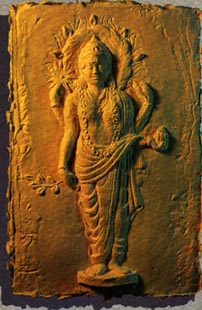
This illustration shows Lord Dhanvantari in His four-armed form holding
the wheel (Sudarsana Chakra) and Conch (sankha) in the upper right and
lefts hands as do most Vishnu incarnations. In the other two hands, there
are the nectar pot (amrta-kalasha) and a herb. According to the Prapancha-sara
sangraha, the Lord holds a leech (jalauaka) in place of the herb in His
fourth hand.
"Within all of us is the archetype of the Divine healer. This Divine
healer is the true healer in all beings, not any particular individual
or special personality. To heal ourselves or others we must set it in motion
within ourselves. Dhanvantari, an incarnation of the God Vishnu, ...represents
this truth in the tradition of Ayurveda. His statue is found at most Ayurvedic
schools and clinics. It is a reminder that however much we know or skillfull
we become, everything still depends on the grace of spiritual nature. Hence,
this book is dedicated to the divine healer within you." writes David Frawley
in the dedication to his book, Ayurvedic Healing.
This illustration by Gail Frawley appears on the cover of Ayurvedic
Healing Copyright 1989 Morson Publishing
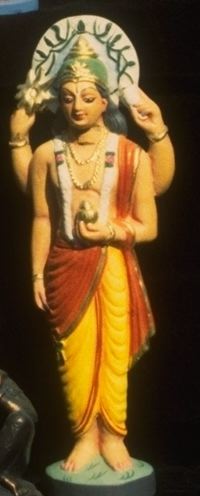
This is a statue of Dhanvantari, sold online through JBL
online. In this representation, there is a leech and a herb along with
the conch and nectar pot.
Udupi Sri Krishna as Dhanvantari
http://www.avatara.org/dhanvantari/dhanwantarir.html
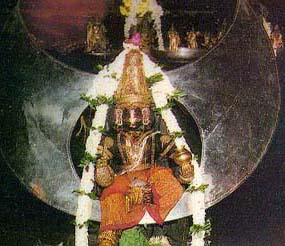
This is an ancient Deity (arca-vigraha) of Lord Krishna currently located
in Udupi, South India. Here Lord Krishna is dressed as Lord Dhanvantari
and one can see the nectar pot (amrta-kalasha) in His hand. Particularly
special is the moon in the background. The ancient text Prapancha-sara-sangraha
descr ibes that one may meditate on Lord Dhanvantari situated on the lunar
orb.
During Lord Krishna's manifest pastimes five thousand years ago, His
wife Queen Rukmini carved and worshipped this Krishna Deity in the kingdom
of Dvaraka.
This was eventually lost and finally rescued by Sri Madhva Acharya
in the 13th century. Today one can see this ancient Krishna Deity worshipped
in Udupi in the southern state of Karnataka, India. The complete details
of this fascinating story are given in Madhva Vijaya, the biography of
Madhvacharya, and the story is summarized at the Dvaita
site.
NOTE:
This is incorrect information. The Deity was carved from a Shaligram
stone by Vishvakarma and then given to Rukmini who worshipped the Deity
during her time in Dwarka See more on my Madhwa
page and Shaigram page on Udupi.
Ancient Dhanvantari Archa-vighraha
http://www.avatara.org/dhanvantari/dhanu.html
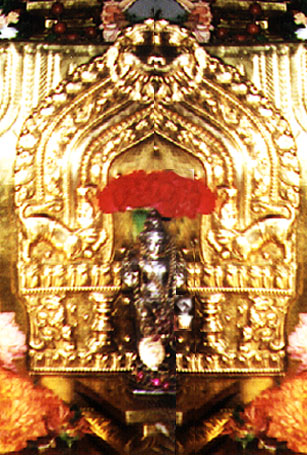
This is an ancient Deity (arca-vigraha) of Lord Dhanvantari that has
been worshipped for 750 years in Udupi, South India. One can see the nectar
pot (a mrta-kalasha) in the left hand of Dhanvantari. His Holiness Sugunendra
Tirtha Swamiji from Udupi is currently on tour in the United States and
worships this Deity of Lord Dhanvantari every day according to ancient
Vedic rites. For info on his tour, see Dvaita
Website.
Special thanks to the Swamiji from Udupi who was kind enough to give
me the darshana and permission for photography of this Deity.
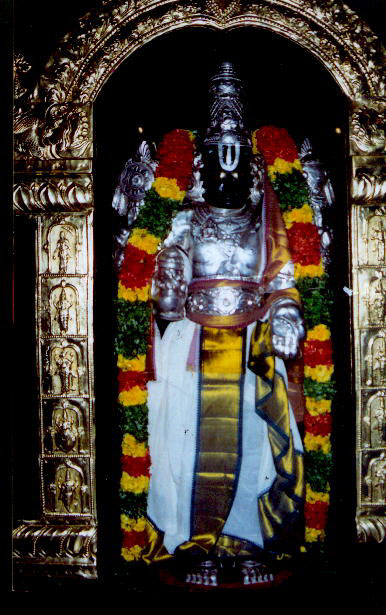
This picture of the Deity of Lord Dhanvantari is a one off, they don't
allow pictures of Him at this temple in South India. It was given to me
as a gift a few years ago, I believe the Deity is either in Melkote or
Sri Rangam.
Sri Dhanvantri Mantra
Om Namo Bhagavate
Maha Sudharshana
Vasudevaya Dhanvantaraye;
Amrutha Kalasa Hasthaaya
Sarva Bhaya Vinasaya
Sarva Roka Nivaranaya
Thri Lokya Pathaye
Thri Lokya Nithaye
Sri Maha Vishnu Swarupa
Sri Dhanvantri Swarupa
Sri Sri Sri
Aoushata; chakra Narayana Swaha
"Obeisances unto the Supreme Bhagavan known as Sudarshana Vasudev Dhanvantari,
the holder of the Kalasha full of nectar of imortality, who removes all
fears, who removes all diseases, the well wisher of the three worlds, and
sustainer of the three worlds, He is Vishnu swarup, by the name Dhanvantari
empowered to heal the Jiva souls."
Sri Dhanvantari Stotram
http://www.avatara.org/dhanvantari/sorta.html
English Translation and Recitation by Dr. Vasant Lad
This ancient stotra glorifies the divine form of Lord Dhanvantari. The
Sanskrit text below has been translated and recited by Dr. Vasant Lad of
the Ayurvedic Institute (Copyright
1994)
CLICK HERE for Audio
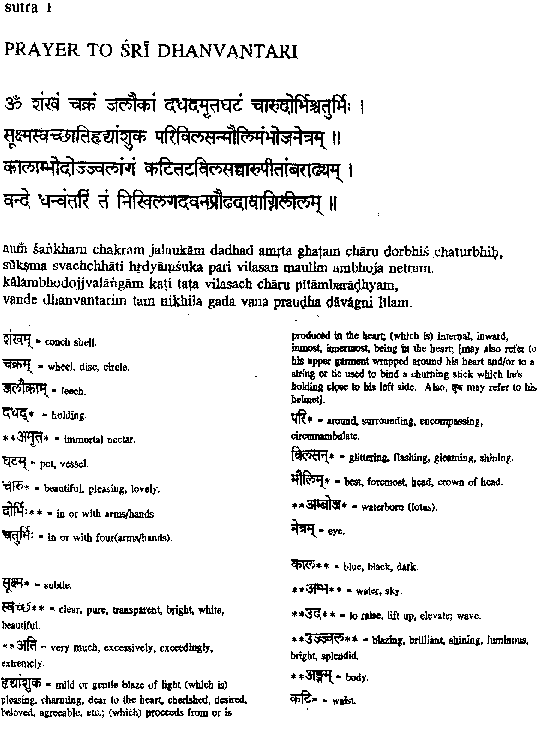
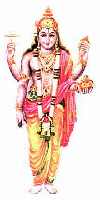 OM
DHANVANTARAYE NAMAHA
OM
DHANVANTARAYE NAMAHA


 OM
DHANVANTARAYE NAMAHA
OM
DHANVANTARAYE NAMAHA